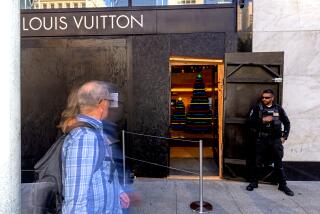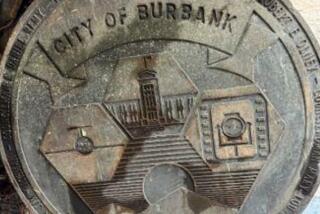Cops of Steel : In Age of Specialization, 2 Officers Known as ‘Junk Cops’ Haunt Scrap Yards in a Search for Metal Thieves
- Share via
Although they don’t ignore steely-eyed characters sporting pistol-sized bulges under their jackets, as a rule Detectives Bob Readhimer and Billy Heinlein seek less obvious crooks.
The trail begins for these detectives, known by fellow Los Angeles police officers as “the junk cops,” in places such as Joe’s Scrap Metal & Sales Co. in North Hollywood.
On a recent visit to the scrap yard, Readhimer spotted evidence of the culprit who is simultaneously the officers’ bane and bread: the elusive metal thief. What caught Readhimer’s eye were five lengths of copper tubing lying on the ground next to a stack of dead car batteries.
“These are highly suspicious,” Readhimer said. Crouching down for a closer look, he noted the pipes’ brassy color and the unfaded markings indicating the manufacturer’s name and specifications. The newness of the pipes made it unlikely that anyone but a thief would have sold them as scrap.
Joe’s was the second of nine San Fernando Valley scrap yards the two detectives visited that day in search of metal thieves, who have been a steady concern of police since 1945, when the first two-man detail of junk cops was assigned to stem the theft of copper wire from public utilities.
200 Cases Last Year
Last year, the detail uncovered more than 200 cases of metal theft citywide. Typically, each will involve an average of about $500 worth of stolen material, Readhimer estimated, although many thefts range much higher in value.
“Most people don’t think the police department would have two detectives assigned to look for junk,” he said. But in the Valley, there is clearly a need for them.
The Valley, which has about a fifth of the city’s scrap yards, accounts for about a third of the more than $1 million in stolen metal recovered annually by the detectives, Readhimer said.
Downtown Los Angeles and the city’s harbor area are also sites of many recoveries, but the Valley’s 12 large scrap yards yield slightly more because the areas they encompass are broader, said Readhimer, 44, who has been chasing metal thieves for eight years.
“We know the metals,” he said. “We know what it may cost a victim to replace those metals. It may cost him his company. It may bring him bankruptcy.”
Yet, almost in the same breath as Readhimer and Heinlein bemoan the exploits of the metal thieves, both say hunting them has been the best police job they’ve ever had.
Heinlein, 43, a 19-year police officer who has been a junk cop only three months, said his new job already has stirred a passion in him.
“I’ve worked narcotics, the buy team, vice, prostitution, pornography, gambling, divisional detectives for five years, rape, robbery, homicide, everything,” Heinlein said. “This is better than anything else I’ve ever done.”
Readhimer concurred. His biggest case, he recalled, was the recovery of a 67-pound circular metal ring that was to be part of a National Aeronautics and Space Administration space shuttle rocket booster.
Aerospace Part
In late 1985, the Canoga Park-based Rocketdyne division of Rockwell International had shipped the part to a Los Angeles subcontractor for X-raying to be sure there were no internal flaws, such as air bubbles.
A thief snatched the ring, which was made of a high-grade, nickel-based alloy called Inconal, and took it to a nearby scrap yard. Not knowing that the piece was worth about $100,000 on the aerospace market, the thief sold it for $26 in the belief that it was stainless steel.
Readhimer got the call from Rockwell officials at 8 a.m. the next day, and in half an hour, he was on the phone with the scrap dealer who, despite his suspicions, had bought it and who had dutifully taken down the seller’s name and license-plate number. The thief later was caught.
Stealing aerospace metal actually is far less common than theft of aluminum, which seems to be the metal in most demand these days, the detectives said. Construction sites seem to be extraordinarily vulnerable because metal often is left in the open, but any company can fall victim to thefts, Readhimer said.
Dishonest Workers
“If it’s metal and it’s laying out, somebody’s going to steal it,” he said.
The detectives estimated that in about 70% of the cases, the thieves have been dishonest employees who began by stealing items as small as nuts and bolts.
“They start carrying out a little at a time,” Readhimer said. “They may carry it out in their lunch pail or their thermos bottle.
“With the extra money, they may buy an extra piece of furniture or a TV,” he said. “That extra money now becomes very important to them, so they have to steal a little more to make payments. We see it snowballing.”
The rest of the theft is by experienced pros who are better at covering their tracks, he said.
“Most of them don’t steal the obvious, the brand-new material, like the new copper tubing,” he said. “They will steal the stuff that has been lying outside several months that people don’t miss.”
Scrap dealers are required by law to report to police the sellers’ names and the items sold, except for cans, steel and batteries. Readhimer and Heinlein said most dealers cooperate.
Perusal of the reports can lead to an investigation, such as one last month in which a Canyon Country woman and her boyfriend, a North Hollywood man, were arrested on suspicion of grand theft, the detectives said. They said the reports showed that the boyfriend had sold two 1,000-pound loads of copper to separate dealers on the same day; the material was later discovered missing from a Chatsworth firm, where the woman worked as an office manager.
Most dealers can tell when a thief is trying to unload stolen metal, said Mike Bushman, owner of Max Scrap Metals Co. in Chatsworth. Bushman said his policy is to refuse, for example, 500 rolls of brand-new soldering wire.
But some contraband slips through. At Bushman’s yard, the detectives have placed a hold on 680 pounds of aluminum scaffolding parts, along with 1,037 pounds of copper tubing from the Chatsworth case.
A company may discover missing metal on its own, Heinlein said. “It’s maybe nuts, bolts or screws with their specifications, and without those contracts, they’re out of business,” he said. “A lot of these companies know the stuff is going to show up in the scrap yards, so they call the yards or they call us.”
Other times, he said, “It’s backwards. You’re finding parts with their name on it before the victims even knew it was gone.”
Making a positive match between a company and the recovered metal is what Readhimer means when he talks about “knowing the metals.” Copper wire from Southern California Edison Co., for example, has a distinctive trait that the detectives will not disclose for fear of losing an edge to potential thieves. Department of Water and Power lines consist of strands of aluminum wrapped around a single strand of steel, which is identifiable by use of a magnet that Heinlein dangles from the end of a wire.
Showing Their Samples
The blue GMC van in which Readhimer and Heinlein roam from junkyard to junkyard contains a miniature version of what could be considered a museum of metals favored among thieves.
Some of the items are recovered property; others are samples that Readhimer can show junk dealers, asking, “Is this what it looks like?”
There are cutting tools of carbide, one of the densest metals produced. There is a shiny chunk of Inconal, the aerospace alloy. And there is a boyish glint in Readhimer’s eye as he holds a recently recovered triangular piece of high-density titanium.
Readhimer is planning to retire soon. That will make Heinlein the new top junk cop.
“After just six months, I will have just barely touched the surface,” Heinlein reflected. “There are so many metals.”
More to Read
Sign up for Essential California
The most important California stories and recommendations in your inbox every morning.
You may occasionally receive promotional content from the Los Angeles Times.










